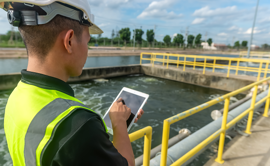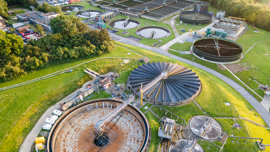Rethinking mains renewal for AMP8: A smarter, holistic approach
Published: 9 July 2025
As the water industry enters AMP8, utilities face a difficult challenge: delivering widescale mains replacement programmes that are not only effective but also efficient, customer-focused, and future-proof. Traditional approaches targeting a single asset type or applying uniform replacement strategies may tick boxes, but they often fall short in delivering meaningful customer benefits or achieving the lowest cost per metre.
From siloed workstreams to strategic system thinking
Historically, investment planning has been segmented into workstreams focused on specific asset types or regulatory drivers. While this structure brings clarity, it can also lead to fragmented decision-making and missed opportunities for synergy.
Our approach breaks down these silos by taking a holistic, source-to-tap view of each distribution zone, integrating performance, risk and cost data across the entire network.

This means evaluating everything from water treatment works and trunk mains to pumping stations, service reservoirs, and distribution mains, all the way to the customer tap.
The power of holistic zonal studies
Targeting zones with overall poor performance doesn’t assume budget constraints or favour specific outcome delivery incentives (ODIs).
Instead, it utilises hydraulic modelling and risk-based analysis to identify the most effective interventions, whether that’s mains replacement, pressure management, new valving, or targeted maintenance like flushing and conditioning.
This will ensure you can:
- Optimise asset lifecycle costs
- Achieve all relevant ODI targets
- Mitigate the risk of asset failure
- Deliver measurable customer and regulatory outcomes
However, with a targeted zonal approach, there is always the risk that this level of granularity may miss some ‘worst-performing assets’, e.g. those in ‘good performing overall’ zones.
For mains replacement performance commitments, our water infrastructure and modelling team has developed a process to skip past the initial area-level targeting and prioritisation assessment and identify all ‘worst-performing mains assets’ upfront.
Evidence-based investment, not guesswork
Proposed schemes should be backed by a robust cost-benefit analysis and a dynamic 'book of schemes' that allows investment decisions to be made with confidence.
Outputs should be:
- Evidential and auditable
- Linked to historical and current ODI performance
- Traceable to specific assets and customer groups
This golden thread ensures that every pound invested is directly tied to customer benefit, whether that’s fewer bursts, better water quality, or improved supply resilience.
Benefits beyond the traditional
This approach delivers tangible, scalable value, including:
- Improved water quality: Targets mains most responsible for water quality failures and water quality complaints
- Reduced burst, leakage and supply interruption rates and high- and low-pressure complaints
- Significant cost savings: Will enable delivery of a portfolio of mains replacement schemes which maximises benefits to customers while averaging a < £292/m replacement cost
- Regulatory compliance: Supports delivery of asset health and water acceptability targets
- Data-driven confidence: Replaces assumptions with evidence-based asset selection
- Long-term planning: Provides a 10-year roadmap for strategic investment
- Scalability: Proven success across utilities, ready to be replicated
- Centrally assured and flexible: Enables mid-AMP pivots with minimal rework thanks to asset-level granularity
- Value-driven decision making: Prioritises interventions with the greatest customer and operational impact
- Single-asset benefits breakdown for every scheme: Empowers clients to revise scope dynamically and instantly understand the revised costs and benefits
- Aligns with Ofwat requirement (2025): For ‘accelerated and optimised water project delivery’
A high-impact, low-cost solution
Undertaking a benefits and hydraulic risk assessment for all assets will enable the best schemes by value (cost) and benefit (leakage reduction, burst reduction, supply interruption reduction, water quality failure reduction, complaint reduction, etc) to be selected for investment.
This could potentially save tens of millions of pounds in the process, transforming how mains renewal is delivered in AMP8 and beyond.
Latest resources
 Insights
InsightsOfwat’s approach to asset management maturity
 Insights
InsightsA strategic response to the Storm Overflow Assessment Framework version 2
 Case Studies
Case StudiesIndependent assurance verifies robustness of Anglian Water pollution reduction programme
 Case Studies
Case StudiesAssurance transformation plan helps Northumbrian Water meet new reporting requirements
Here to solve your biggest challenges and grow sustainable value
Our expert consultants are available to broaden your thinking, lead transformation, and help you achieve successful outcomes.
Contact our experts

